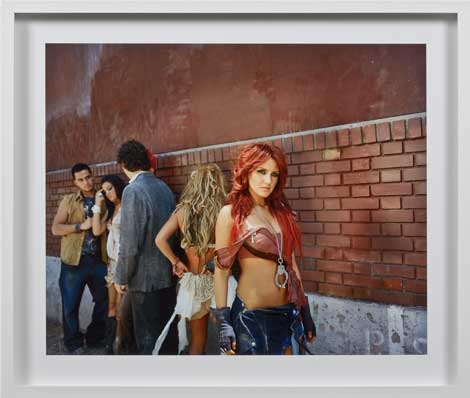Shot from behind a glass partition, a girl with long blond hair sits alone at the edge of an empty pool. Her back is to the camera; her legs create ripples in the blue water. Where the pool ends, a golf course begins. The setting is obviously one of wealth. This color photograph by Yvonne Venegas, from the “Unpublished” series (all works 2006) entitled Alberca [Pool], shot on the set of the Mexican telenovela Rebelde [Rebel], depicts one of the actors from the show. It is unclear whether this is a moment of contemplation for the character or a break in filming. In her work, Venegas plays with the artifice implicit in photography and explores the relationships between posing and acting; “Unpublished” blurs the boundaries between documentary and publicity photography.
Invited by the producers to document the activities on the set of Rebelde during its last six weeks of filming, it was assumed Venegas would create a set of images celebrating the show. Her photographs were rejected, presumably because she chose to blur this line. While a few images depict scenes during shooting, Venegas was more interested in what the actors did when they were not on camera and how they behaved outside the studio. Rebelde, a popular soap opera that chronicled the lives of a group of students at an elite boarding school, then spawned a band formed by the six main characters. The band developed a true following and toured internationally, becoming a sensation off the screen.
The images in “Unpublished” range from photographs of the actors in costume as uniformed students to their teen and younger fans dressed to match their idols. Venegas followed the band to Madison Square Garden, documenting both their presence on stage and the press photographers hungry to capture their image. Dulce posando [Dulce posing] depicts the character playing Dulce in a mini skirt and bustier with a handcuff necklace: certainly more the look of a groupie than the wardrobe of a high school student. But that is Venegas’ point: actors are hired to play the part of students who then take their character out of the confines of the script and into the real world. Are they required to remain in character? Is this an image of Dulce or the actress who plays Dulce? A photographer like Philip-Lorca di Corcia will hire actors and instruct their poses to simulate candid moments whereas Venegas captures her actors both acting and not, leaving her viewer to decide which is which.
In a related body of work, “Gestus,” referring to an acting technique developed by Bertolt Brecht—the embodiment of attitude—Venegas explores what is revealed through pose and gestures. Black-and-white images of both photographers and those being photographed are push-pinned to the wall in a loose grid illustrating the awkwardness in the moments before the shutter is pressed. These images are not as carefully composed or constructed as those in “Unpublished” yet more directly speak to the differences between documentary and publicity photography where context reiterates these categories.
Venegas is fascinated by how people behave in front of a lens and has documented both rich and poor in her various series. Yet, though she has captured a cross section of subjects, she does not pass judgment nor offer a critique, but rather presents a range of attitudes between subject and photographer that toy with the differences between candid and staged.


